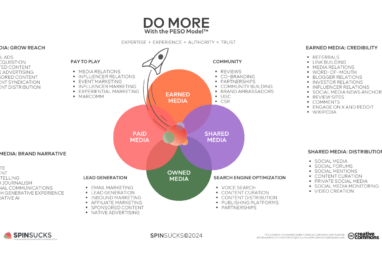Corporate storytelling
Creating and strengthening emotional connection with your organisation
About the author
Victoria Gregory wrote this article as part of a CIPR Professional PR Diploma assignment, studying with PR Academy.

Storytelling has existed since the beginning of time and today is often lauded as a mark of great leadership. A story told well creates an emotional reaction and most essentially, leads to action from its audience. It simplifies the frantic overload of information that we are busy trying to process and provokes a response which is usually intended to be positive.
But why do stories create these emotional responses and what is their usefulness in the corporate world?
The answer lies in the science of the human brain. But worry not, you do not need to be a cognitive psychologist to tap into this tool.

A simple google search can tell you that the human brain processes around 11 million pieces of information per second but we do not even realise we are receiving most of this information. We actually consciously process about 40 pieces of information per second, but even that is a significant number to contend with in a fleeting moment. So how do we choose what to process and remember? More importantly how do we act on this information in the way intended?
Remember how we used to be told not to allow emotions to muddy the waters when making a decision? Well, forget that.
Our emotional response is governed by the limbic system, a part of the human brain that also deals with memory, and research undertaken by Damasio (2000), revealed that a brain ‘that cannot feel cannot make up its mind’. If we want to persuade our audience, we have to connect with them emotionally.
Our emotional responses, when backed by data and facts, actually help to make decisions that we are happy with and therefore we are more likely to make the decision and take the course of action that is desired.
A story told well helps to form that emotional connection that makes the overloaded brain take notice and form a course of action.
To ask people to learn through the rote of facts and figures does not humanise the information in the way that a story can; the impact is lessened, and everything becomes less memorable.
We have all experienced storytelling in one form or another since early childhood. But if we look back, we find that sometimes we quickly drifted off as the story was being told, our minds distracted by anything and everything, especially when the relevance of the story wasn’t immediately apparent.
Structure is therefore absolutely imperative in the corporate world – it places relevance at the forefront of the narrative and helps to tie the corporate story or message with the emotion to make it more memorable. .
Set the scene, in other words provide the context; what is the background? Think about who, what, where, when and why, what is the main issue, what is the problem the protagonist is facing? This is the opportunity to grab the audience’s attention. Why should I, your recipient, be troubled enough to take action?
The second part of the story should focus on what happens next. This is where the action happens. In a fairy-tale for example, this would be where the knight fights the dragon, or in the context of the corporate world, where the structure of the organisation changes, or the strategic vision of the company is updated.
And finally, the result, what happened? Who won, who lost, what did the characters learn? Think back to the start of your story, link back to the reason why.
An easy way to remember this is the acronym CAR: Context, Action, Result. Denning goes further with this analogy and advises CAR=STORY, leaning into some of the detail each section should contain, Subject, Treasure, Obstacle, Right lesson and whY.
Stylistic elements also need to be carefully considered. There is a time and place for company jargon or the words that mean everything but say nothing. Rule of thumb should be to keep it simple, write how you speak, speak how you speak! Be concise, be clear, be understood.
The ladder of abstraction can also be used as a tool to make the message more memorable. Described by American linguist, S. I. Hayakawa, in his 1939 book Language in Action, Hayakawa explains that the higher up the ladder you are the more abstract the idea, language or thought is. The lower you are on the ladder the more concrete the idea, language or thought is. If you choose and use your words correctly people will react with “I see what you mean” even though you did not show them anything. Their mind creates the image, images create memory.
By investing our energy into storytelling, we are working to persuade. Persuading our employees. Persuading our shareholders. Persuading our customers that this is the right course of action by taking them on the journey of the ‘why’ to achieve a result that benefits all.
We need to look at persuasion in a little more detail. Let’s go back to the limbic system for a moment, where we have understood that an emotional connection is really the crux of getting people to accept and act upon what you are asking them to do. What this means in simple terms is that if the audience cannot quickly grasp why they are being asked to do this specific action or change, what it means for them, then they simply cannot be persuaded to act.
If storytelling is the tool, what is the persuasive moment?
The Elaboration Likelihood Model was developed 40 years ago, in 1980, by Petty & Cacioppo and homes in on two routes of persuasion: central route and peripheral route. These routes describe the ways in which a person can receive and process information leading to the making of a decision or forming of an opinion.
When a person carefully considers the key points of a message and focuses on the facts and figures, including visual cues, they are viewed as having a high level of message elaboration. They are also likely to hold firm to their thoughts and feelings. This is the central route. It is important that the listener feels connected to and understands the message. If they don’t, they simply will not process it.
When an individual is responsive to the facts and figures but also considers other points, which can be as varied as what the speaker looks like or how much they sound like an expert, they are considered to have a low level of message elaboration and this is the peripheral route. This audience will not always follow the logical route that the facts would have you take.
As a storyteller, how would you instinctively know whether you are working with a peripheral route audience or a central route audience? The simple answer: you won’t. You will probably find that within your varied audiences you will encounter a mix of people who process information quite differently but you can make a fairly educated assumption depending on who you are talking to and what your desired outcome is.
It is noted in this research that an individual’s ability for message elaboration is affected by their motivation, personal relevance, attitude, as well as their knowledge base and how distracted and busy they are. You could suppose that a companywide announcement that may impact structure and jobs would have a captive audience, or a shareholder interested in their dividends would be far more invested in listening to the facts and figures and consequently have a high level of message elaboration. Whereas a customer who stocks a similar competitor product which is performing well for them does not have a need or personal interest in your message and would perhaps have a low level of message elaboration.
There is a message of caution here, as much as you can persuade your audience of your message, if you do not get it right you can change the attitude to one of a more negative persuasion.
Both routes have their advantages, high level message persuasion is deemed to be long lasting whereas the peripheral route is advantageous to those who are time poor or less invested in the outcome.
If you delve deeper into persuasion, we start to understand more about the principles of persuasion such as hedonistic persuasion which considers the feelings of love, pleasure and comfort, through to ethical persuasion – what is right and wrong, the freedom of choice, religious beliefs and respect.
But ultimately, what is the point of a story? Stories help create empathy. Stories are memorable. Stories are understandable and familiar.
It is important to remember that storytelling in an organisation is not just about entertainment, that is just how to get people’s attention, the truth is what matters.
Throughout history, storytelling has been used to inform and advise, to warn of danger, to celebrate success, to create action. The storyteller needs to create that emotional connection with their audience, talk of their personal challenges, their experiences and their own journey. Bring the audience into your story, create empathy and connect with them, demonstrate vulnerability and challenges. The story you tell can work across all the audiences; it all comes together in the way you tell it. Be adaptable, read your audience, be passionate, build a narrative that provokes a reaction, rehearse but do not be afraid to change it to suit the situation.
We know that emotion is crucial, but we should not lose sight of the fact that every great story needs a plot. Most stories start with a vague idea of what you want to tell people but how do you decide the right plot?
Tobias describes the need to create a deep structure with morality as the centrepiece. This is not the normal question of morality we experience; it is the provocation of ‘how should I act in these circumstances’?
Whilst we would like to think about decisions as good or bad, wrong or right, black or white, there is often a lot of grey where uncertainty reigns. To tackle the grey creates the tension required, it’s not just about the good guy winning the day. Plots aren’t new, they are familiar and resonate with the audience, they are typical and relatable and as Henry Miller states: “Who is original? Everything that we are doing, everything that we think exists already, and we are only intermediaries, that’s all, who make use of what is in the air”.
Tobias goes on to describe the 20 master plots; adventure, rescue, escape, revenge and rivalry, to name but a few. These models all have their usefulness but carefully consider the context before deciding your plot.
As a collective, we are all currently living the same story in different ways. Stay at home. Protect the NHS. Save lives.
We have the context – COVID-19 is a worldwide pandemic and people are dying.
We have our action -we must stay at home and protect our health service and the result will be the saving of lives. We have been brought into the narrative; we are our own heroes. By staying at home, we are already saving countless lives. We have the heroes we can look to: Captain Tom Moore inspired a nation with his own story of raising money by simply walking in his garden. Clearly there is more to it than that; for a man turning 100 this was no mean feat! We will be able to tell this story to our children and our children’s children… about a nation coming together during a moment of crisis and the part we all played. The emotional connection of those three statements puts us in the thick of the story.
From the moment we hear our first fairy-tale or children’s story, they influence our viewpoints, actions and ambitions. They shape our sense of what is right and wrong, good or evil, helping us to make our biggest decisions. The power of storytelling exists in all facets of our lives and its role within the corporate world can make the difference between a good leader and a great leader, between success and failure. The next time you are invited to a presentation think about your story, think about the emotional engagement and reaction you want to create.
Remember you do not need to invent a new story; they are all around us but the riveting emotion you attach to it will make you stand out.


